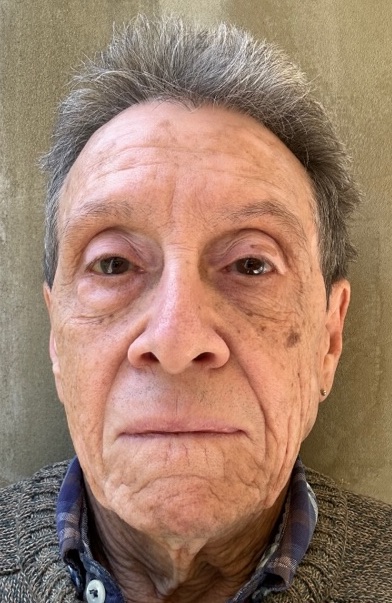 [In spring and summer of 2018 I served as an expert witness in Graham v. Prince et al (15‑cv‑10160) and McNatt v. Prince et al (16‑cv‑08896), providing my services pro bono
[In spring and summer of 2018 I served as an expert witness in Graham v. Prince et al (15‑cv‑10160) and McNatt v. Prince et al (16‑cv‑08896), providing my services pro bono
At the time I got involved, these cases — filed against wealthy “appropriation art” practitioner and serial hacker Richard Prince by photographers Donald Graham and Eric McNatt for Prince’s unauthorized use of their images — were merged, so my testimony applied to both. Subsequently the cases got separated. Recently, as they headed to trial, they got settled. (See “Richard Prince to Pay Photographers Over $650,000 In Copyright Lawsuits,” by Pesala Bandara, PetaPixel, January 29, 2024.)
I like to think that my rebuttal contributed in some ways to the court’s decision, and also that it makes interesting reading in its own right. (It pleases me to report that Prince and his attorneys repeatedly asked the court to exclude my testimony, which request the court repeatedly denied.) As it’s now on the record as a public document, and the cases have resolved, I’m publishing it here. I’ve stripped out some of the boilerplate — my credentials, etc. — to make it more readable.
Part 2 appears below. Click here for part 1, and here for part 3. If you prefer to read the whole thing, complete with professional boilerplate, you can download a PDF of the brief here.— A.D.C.]
•
U.S. District Court for the Southern District of New York
Case No. 1:16-cv-08896-SHS
Rebuttal Report of Allan Douglass Coleman (b)
… While postmodern theory claims the status of “theory,” most of its ideas are not subject in any way to either proof or disproof, in the scientific and/or legal sense. Thus their claim to any sort of validity and authority is arguable at best; they have only whatever credibility high-profile cultural figures — such as those providing expert reports on Mr. Prince’s behalf — have granted them.
It is also important to point out that postmodern theory has not achieved even the universal acceptance in the U.S. that would signify at least widespread cultural acceptance (which of course does not constitute proof). In the world of music, for example, the practice known as “sampling” — the re-use in one’s own work of brief soundbites from recordings by other artists, effectively creating a collage of audio elements — has become commonplace.
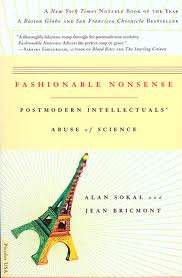
Alan Sokal and Jean Bricmont, “Fashionable Nonsense” (1998), cover.
However, unlike postmodern practice in the visual arts, “sampling” has led to the establishment of clear rules and regulations resulting in a robust subsidiary rights-licensing division of the music industry, to the benefit of the makers of the sampled music, who receive both financial reward for their sampled output and on-the-record recognition for their contributions to the works that use their material.
Nor has postmodern theory achieved uniform acceptance even within the microcosms of the contemporary art world and academe. Indeed, the Alan Sokal/Social Text controversy, in which a physicist demonstrated that a prominent journal of postmodern thought was susceptible to publishing “fashionable nonsense” — in that case, the ridiculous claim that gravity is merely a social construct (see http://www.physics.nyu.edu/faculty/sokal/#papers); the online availability of the Postmodernism Generator, a website that generates endless postmodern essays via an algorithm (http://www.elsewhere.org/pomo/); and other parodic responses to postmodern theory make clear its many weaknesses.
Notably, despite the assertion — implicit in Mr. Prince’s artistic practice generally, in his actions in the current case, and in the postmodern theory to which he avows he subscribes — that the concepts of authorship and individual creativity are dead, he and the experts providing reports on his behalf in this case effectively claim that in one way or another Mr. Prince has established his own authorship and creativity in relation to the appropriated works, by putting a distinctive creative imprimatur thereon through various devices that they single out: recontextualization, addition of textual elements, changes of size and shape and medium, etc. This strikes me as both self-contradictory and hypocritical.
•
To assess the purpose and character of the Prince Works, I divide the analysis into two parts. First, I assess whether the Prince Works are transformative of Plaintiffs’ Works. Second, I assess whether the Prince Works are commercial in nature. I conclude that (1) the Prince Works are not transformative of the Plaintiffs’ Works, and (2) the Prince Works are commercial in nature.
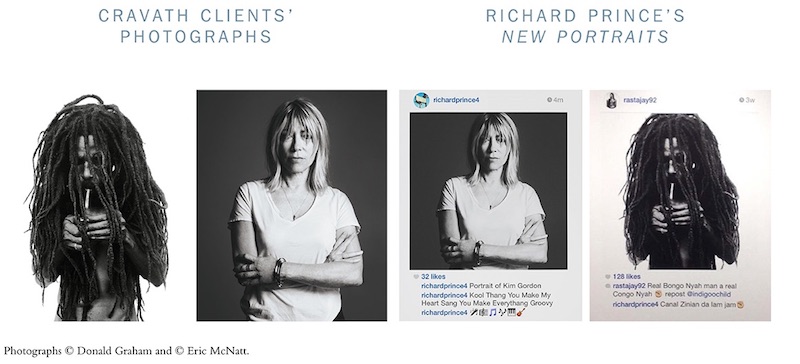
Comparison of Donald Graham and Eric McNatt photos to Richard Prince derivations, Cravath, Swaine & Moore LLP website, screenshot
•
To assess transformativeness, I consider (1) whether Plaintiffs’ Works are the dominant images in the Prince Works; (2) whether the Prince Works transform the Plaintiffs’ Works by changing the composition, presentation, scale, color palette and media originally used in Plaintiffs’ Works; (3) whether comment automatically constitutes alteration and (4) whether the Plaintiffs’ Works are transformed by Prince, as distinct from the image/text Instagram posts which included Plaintiffs’ Works.
Mr. Graham made the original version of his image, from which all subsequent variations derive, using a Nikon camera loaded with black and white film, generating negatives from which he subsequently printed his images on photographic paper. He has subsequently issued what in the field of contemporary art and photography are known as “original” prints of that image, made in the darkroom on photographic paper, for exhibition and sale; and published them online in the form of low-resolution (72 dpi, or dots per inch) digital versions at his own website.
Someone — without Mr. Graham’s authorization — downloaded that low-resolution derivation of Mr. Graham’s image of this Rastafarian man and uploaded it to Instagram, adding to it a caption.
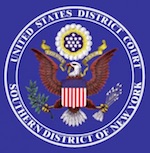 As a preliminary matter, I clarify my use of the term “image” in the following analysis of the works by Graham, McNatt, and Prince.
As a preliminary matter, I clarify my use of the term “image” in the following analysis of the works by Graham, McNatt, and Prince.
Mr. McNatt made the original version of his image, from which all subsequent variations derive, in color using a Canon EOS 6D 20.2 MP SLR digital camera, and subsequently converted the image to black and white. The image was first published on or about September 9, 2014 in Paper’s thirtieth-anniversary edition, online and in print, and on an Instagram account controlled by Paper (a fashion and pop culture magazine). …
•
In each case, Paper published the image under license from Mr. McNatt and with a credit acknowledging Mr. McNatt’s authorship. I understand that Mr. McNatt subsequently licensed a digital version, and published digital copies on his website, Instagram and other social media accounts. Mr. Prince, without seeking or receiving permission from Mr. McNatt, copied and reproduced the image as it appeared on an Internet website. Mr. Prince uploaded a digital copy using his own Instagram account.
Mr. Prince, via a hack, added his own “gobblygook”[1] text to those two Instagram posts, then performed what are called “screen grabs” of the altered posts, which resulted in low-resolution digital copies thereof (in a digital-image format such as a .jpg) downloading to his own computer. With these images, derived in part from online versions of the original images of Mr. Graham and Mr. McNatt, Mr. Prince generated the works that are under consideration in this case.
All of these artifacts — the original images and derivatives thereof produced by Mr. Graham and Mr. McNatt, and the derivatives produced by Mr. Prince — qualify as images. That is, by their nature as objects and artifacts of a particular type, the physical and digital forms of their presentation define them as images.
•
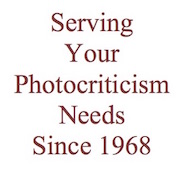 In his derivations of the Instagram posts Mr. Prince has “appropriated” the entirety of both Plaintiffs’ images, while in the “Twitter compendium”[2] he has “appropriated” the cropped central section of Mr. Graham’s, all three of them presented “verbatim,” so to speak — that is, without any visible alteration of their content. Further, it is obvious that Plaintiffs’ Works are the dominant imagistic components in the Prince Works. Nonetheless, Brian Wallis and others claim that Mr. Prince sufficiently “transformed” the photographs in question — via changes in scale, medium, etc. — that they became new works under the copyright law. I consider that argument specious. …
In his derivations of the Instagram posts Mr. Prince has “appropriated” the entirety of both Plaintiffs’ images, while in the “Twitter compendium”[2] he has “appropriated” the cropped central section of Mr. Graham’s, all three of them presented “verbatim,” so to speak — that is, without any visible alteration of their content. Further, it is obvious that Plaintiffs’ Works are the dominant imagistic components in the Prince Works. Nonetheless, Brian Wallis and others claim that Mr. Prince sufficiently “transformed” the photographs in question — via changes in scale, medium, etc. — that they became new works under the copyright law. I consider that argument specious. …
Notes:
[1] Gagosian website, “Richard Prince New Portraits” https://www.gagosian.com/exhibitions/richard-prince–june-12-2015
[2] I understand that Mr. Prince created and/or displayed a compilation of two copyrighted photographs consisting of Graham’s “Rastafarian Smoking a Joint” (cropped to the subject’s face and hands, revealing the subject’s act of lighting a marijuana cigarette) and a cropped copy of another photograph. Mr. Prince posted to Twitter this compilation, accompanied by Mr. Prince’s message: “Booze Pot Sex. I guess I was wrong. (Memo to Turner: I DID NOT take make create this montage).” Graham Compl. ¶¶ 8, 56.
•
This post supported by a donation from 20×24 Holdings LLC.
•

Special offer: If you want me to either continue pursuing a particular subject or give you a break and (for one post) write on a topic — my choice — other than the current main story, make a donation of $50 via the PayPal widget below, indicating your preference in a note accompanying your donation. I’ll credit you as that new post’s sponsor, and link to a website of your choosing.
And, as a bonus, I’ll send you a signed copy of my new book, poetic license / poetic justice — published under my full name, Allan Douglass Coleman, which I use for my creative writing.






Leave a Comment